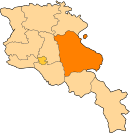For the village in Nagorno-Karabakh, see
Zoğalbulaq .
Place in Gegharkunik, Armenia
Drakhtik (Armenian : Դրախտիկ ) is a village in the Shoghakat Municipality of the Gegharkunik Province of Armenia .[ 2]
Etymology
The village was previously known as Tokhluja [ 3] [ 4] Azerbaijani : Toxluca ;[ 5] Russian : Тохлуджа ;[ 6] [ 7] Armenian : Թոխլուջա [ 8] [ 5]
History
Drakhtik, then known as Tokhluja, was part of the Nor Bayazet uezd of the Erivan Governorate within the Russian Empire .[ 6] Bournoutian presents the statistics of the village in the early 20th century as follows:[ 4]
Ownership
Treasury
Inhabited space
21 desyatinas (0.34 sq km)
Vegetable gardens
3 desyatinas (0.05 sq km)
Irrigated plowed fields
24 desyatinas (0.39 sq km)
Unirrigated plowed fields
1,156 desyatinas (18.94 sq km)
Unirrigated fodder fields
460 desyatinas (7.54 sq km)
Yaylaks 362 desyatinas (5.93 sq km)
Total land
2,026 desyatinas (33.20 sq km)
Total households
155 (All Tatar (later known as Azerbaijani ))
Total income
7,291 rubles
Total land taxes
1,624.83 rubles
Army tax
255 rubles
Upkeep of officials
526.36 rubles
Total revenue
2,406.19 rubles
Large livestock
1,490
Small livestock
1,309
Economy
The population is engaged in animal husbandry, vegetable growing and grain cultivation.[ 9]
Demographics
The population of Drakhtik since 1829 is as follows:[ 9] [ 8] [better source needed
Year
Population
Note
1829
296
1831
100% Muslim
1873
466
100% Tatar (later known as Azerbaijani )
1886
681
1897
935
100% Muslim. 495 men and 440 women.[ 7]
1904
1,170
1914
1,373
Mainly Tatar. Also recorded as 1,285
1916
1,330
1919
1,199
Mainly Turkish
1922
1,176
100% Turkish-Tatar
1926
1,413
1,403 Turks, 5 Armenians, 5 Russians. Also recorded as 1,417
1931
1,723
100% Turkish
1939
1,840
1959
1,528
1970
2,469
1979
2,664
2001
1,044
2004
871
2011[ 1]
909
Gallery
References
^ a b Statistical Committee of Armenia . "The results of the 2011 Population Census of Armenia" (PDF) .^ Kiesling, Brady; Kojian, Raffi (2005). Rediscovering Armenia: Guide (2nd ed.). Yerevan: Matit Graphic Design Studio. p. 83. ISBN 99941-0-121-8 ^ Kiesling, Brady (June 2000). Rediscovering Armenia: An Archaeological/Touristic Gazetteer and Map Set for the Historical Monuments of Armenia (PDF) . Archived (PDF) from the original on 6 November 2021. ^ a b Bournoutian, George A. (2018). Armenia and Imperial Decline: The Yerevan Province, 1900–1914 Routledge . ISBN 978-1-351-06260-2 OCLC 1037283914 .^ a b Nişanyan, Sevan . "Draxtik" . Index Anatolicus (in Turkish). Retrieved 31 January 2024 .^ a b Кавказский календарь на 1910 год Caucasian calendar for 1910 ] (in Russian) (65th ed.). Tiflis: Tipografiya kantselyarii Ye.I.V. na Kavkaze, kazenny dom. 1910. Archived from the original on 15 March 2022.^ a b Troinitsky, N. A. (1905). Населенные места Российской империи в 500 и более жителей с указанием всего наличного в них населения и числа жителей преобладающих вероисповеданий, по данным первой всеобщей переписи населения 1897 г. Populated areas of the Russian Empire with 500 or more inhabitants, indicating the total population in them and the number of inhabitants of the predominant religions, according to the first general population census of 1897. ] (in Russian). Saint Petersburg: Tipografiya Obshchestvennaya polza. p. 55. Archived from the original on 10 August 2022. ^ a b Korkotyan, Zaven (1932). Խորհրդային Հայաստանի բնակչությունը վերջին հարյուրամյակում (1831-1931) The population of Soviet Armenia in the last century (1831–1931) (PDF) (in Armenian). Yerevan: Pethrat. Archived from the original (PDF) on 2 February 2022. ^ a b Հայաստանի Հանրապետության բնակավայրերի բառարան Republic of Armenia settlements dictionary ] (PDF) (in Armenian). Yerevan: Cadastre Committee of the Republic of Armenia. 2008. Archived from the original (PDF) on 11 March 2018.
External links




